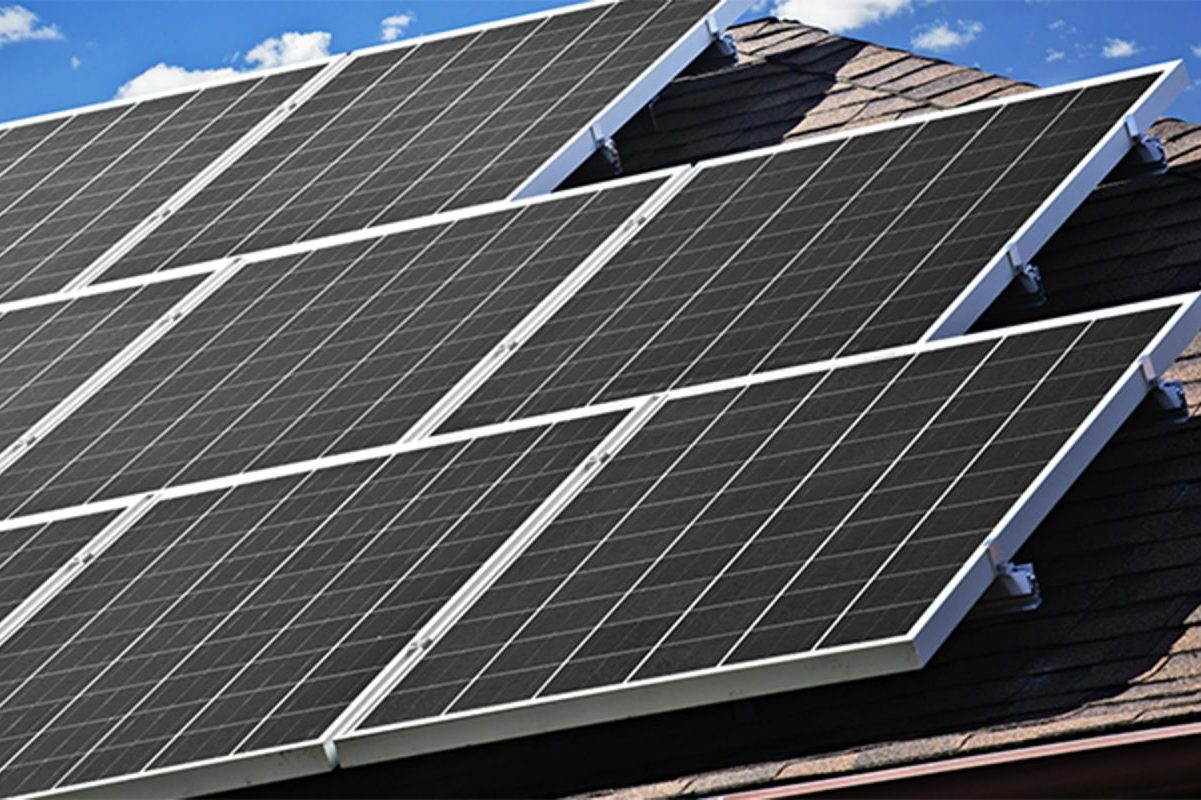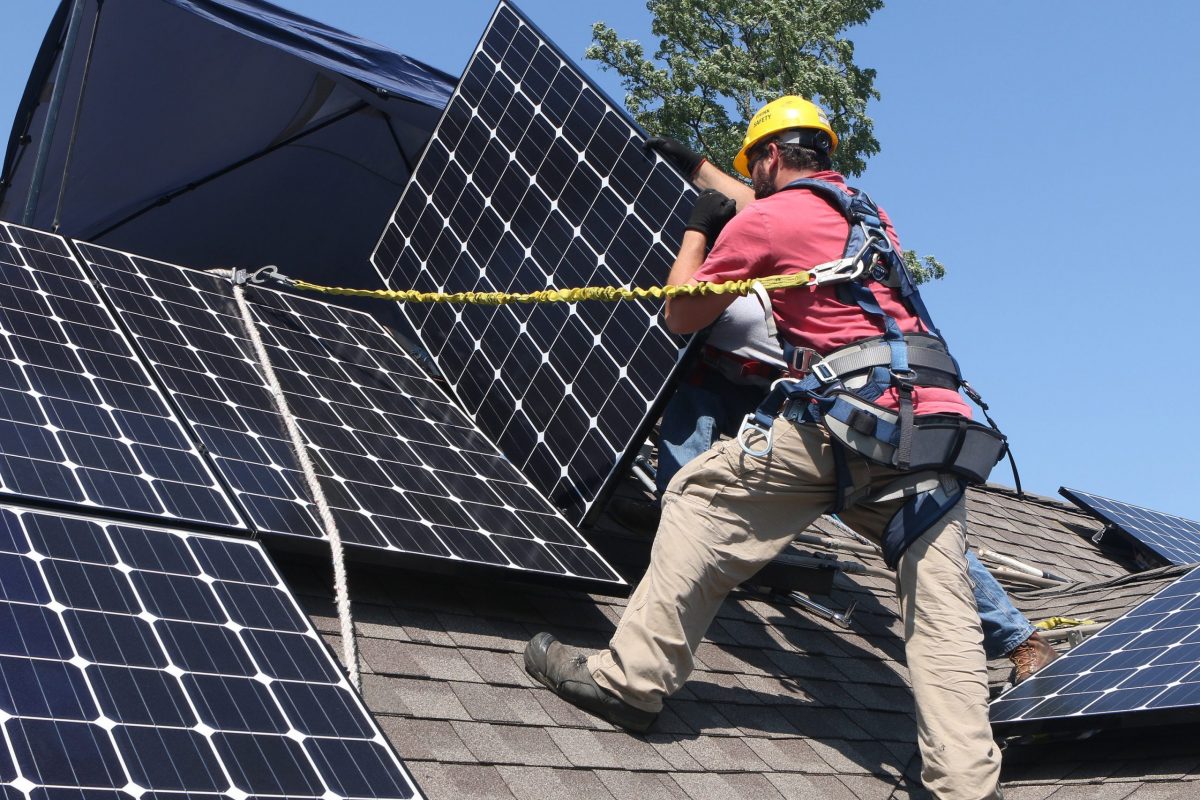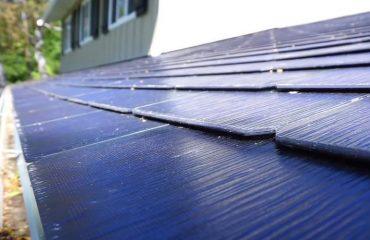Harness the sun’s endless energy to power your home’s water systems while slashing utility bills and reducing environmental impact. Solar-powered water systems represent a revolutionary shift in how we heat, pump, and distribute water, offering homeowners a sustainable solution that pays for itself over time. From solar water heaters that can provide up to 80% of your household’s hot water needs to advanced photovoltaic pumping systems that ensure reliable water access even during power outages, these innovative technologies are transforming residential water management.
By converting abundant sunlight into usable energy, these systems operate independently of the grid, providing reliability during outages and significant cost savings throughout the year. Whether you’re looking to heat your pool, power your well pump, or supply hot water for daily use, solar-powered water systems offer a practical path to energy independence and sustainable living. Modern installations seamlessly integrate with existing plumbing, requiring minimal maintenance while delivering maximum efficiency and environmental benefits.
The combination of falling solar panel prices, improved technology, and available tax incentives has made solar water systems more accessible than ever, offering homeowners a smart investment that benefits both their wallet and the planet.
How Solar-Powered Water Systems Transform Your Home
Core Components That Make It Work
A solar-powered water system relies on four essential components working together seamlessly. At its heart are solar panels, which convert sunlight into electricity. These panels, typically mounted on your roof or in a sunny yard location, generate clean energy to power the entire system. Like other smart home solar solutions, they’re designed to maximize energy production even on cloudy days.
The second key component is the water pump, which comes in two main varieties: surface pumps for above-ground water sources and submersible pumps for wells. These efficient pumps are specifically designed to operate on DC power directly from the solar panels, eliminating the need for power conversion.
Storage tanks form the third crucial element, serving as reservoirs that store water for use when sunlight isn’t available. These tanks can be sized according to your household’s needs, typically holding enough water for several days of regular use.
Finally, the controller acts as the system’s brain, managing power flow between the panels and pump while protecting against issues like dry running or overflow. Modern controllers often include features like automatic shut-off and performance monitoring, making the system virtually maintenance-free and incredibly reliable for daily use.
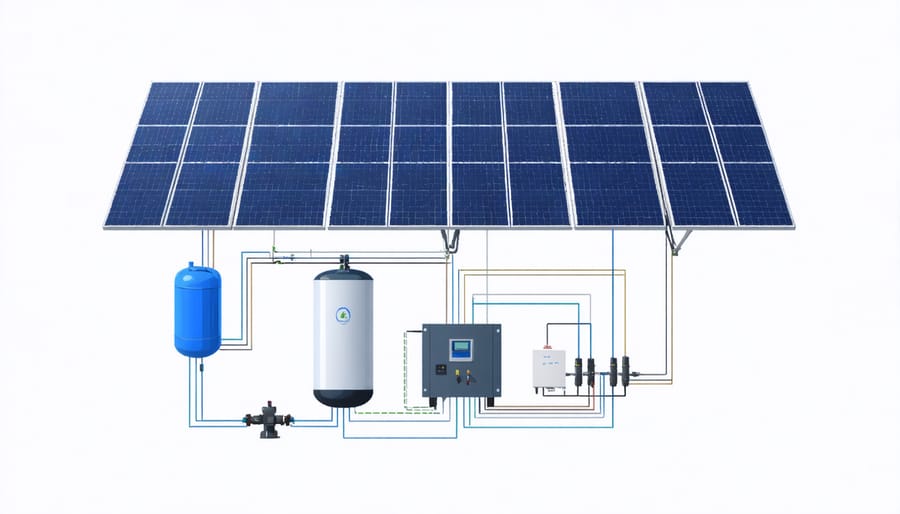
From Sunlight to Running Water
Solar-powered water systems operate through a beautifully simple process that harnesses the sun’s energy to keep your water flowing throughout the day. When sunlight hits your solar panels, they convert this natural energy into electricity, which powers a specialized pump system. This pump then moves water from your source – whether it’s a well, storage tank, or municipal supply – to where you need it in your home.
During peak sunlight hours, typically from mid-morning to late afternoon, the system operates at maximum efficiency. Any excess energy generated during these times can be stored in batteries for use during cloudy periods or at night. This ensures you have a reliable water supply 24/7, regardless of weather conditions.
The system includes several fail-safes to maintain consistent performance. A controller monitors water levels and system pressure, automatically adjusting pump speed to match your household’s needs. When water demand is low, excess energy is directed to storage, and when demand increases, the system draws from both solar and stored power to maintain steady water pressure.
What makes this system particularly appealing is its ability to adapt to changing conditions. On bright sunny days, it might run entirely on direct solar power, while on overcast days, it seamlessly switches to stored energy, ensuring you never experience an interruption in your water supply.
Real Benefits for Your Home and Wallet
Slash Your Water Heating Bills
Making the switch to solar water heating can dramatically reduce your monthly utility bills, with many homeowners reporting savings of 50-80% on their water heating costs. Just like other solar home energy savings, the financial benefits are both immediate and long-lasting.
Let’s break down the numbers: A typical family of four spends around $600-800 annually on water heating using conventional systems. With solar water heating, this cost can drop to just $150-250 per year. While the initial investment ranges from $3,000 to $6,000 after incentives, most homeowners recoup their costs within 4-6 years.
Consider this real-world example: The Johnsons in Arizona installed a solar water heater in 2020. Their monthly water heating bills dropped from $65 to just $15, saving them $600 in the first year alone. Adding available tax credits and rebates, their system will pay for itself by 2025.
The savings become even more significant as energy prices continue to rise. Unlike conventional water heaters that are vulnerable to fluctuating energy costs, solar water heating systems provide predictable, low-cost operation for 20+ years. Plus, many states offer additional incentives that can reduce your upfront costs by 30% or more, making the switch to solar water heating an even smarter financial decision.
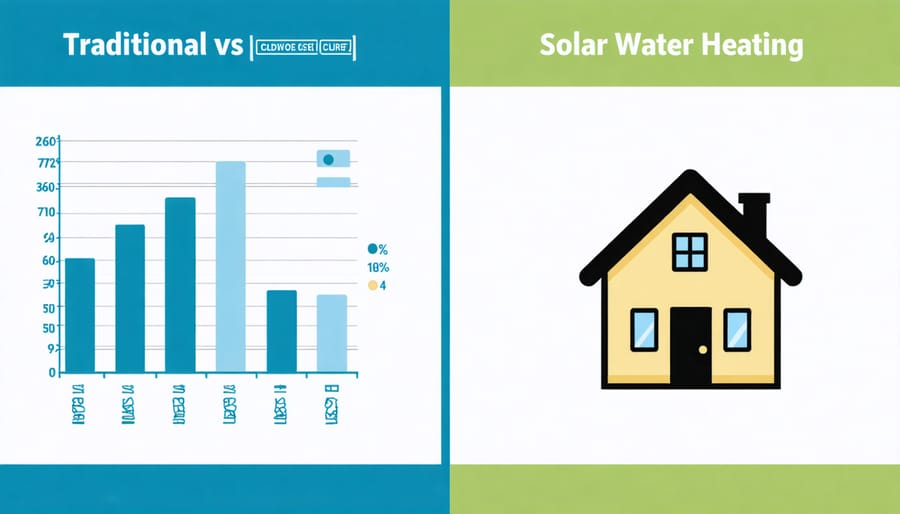
Weather Any Power Outage
One of the most significant advantages of a solar-powered water system is its ability to function during power outages. Traditional water systems rely heavily on grid electricity, leaving households vulnerable during blackouts. With a solar-powered setup, you maintain access to clean water regardless of what’s happening with the power grid.
This independence becomes particularly valuable during natural disasters or severe weather events when grid power might be unavailable for extended periods. Your solar-powered water pump continues working during daylight hours, ensuring your family has access to essential water supplies for drinking, cooking, and basic hygiene.
For homes with wells, this benefit is even more pronounced. While conventional well pumps cease operating during power failures, solar-powered well pumps continue drawing water as long as there’s sunlight. By incorporating a battery storage system, you can even extend this functionality into the evening hours, providing truly round-the-clock water security.
The peace of mind that comes with knowing your water supply isn’t at the mercy of the power grid is invaluable. Whether it’s a brief afternoon outage or a prolonged emergency situation, your household remains self-sufficient for its water needs. This resilience not only ensures your family’s comfort and safety but also maintains your property’s functionality when traditional systems fail.
Boost Your Home’s Value
Installing a solar-powered water system can significantly boost your property’s market value and appeal to potential buyers. Modern homebuyers increasingly prioritize sustainable features, making solar-powered home features a valuable selling point.
Recent real estate studies suggest that homes with solar installations typically sell for 4.1% more than comparable properties without solar features. For the average U.S. home, this translates to an additional $9,000 to $15,000 in value. Solar-powered water systems, in particular, stand out as an attractive feature because they offer both environmental benefits and tangible cost savings.
The appeal extends beyond the immediate financial advantages. Prospective buyers are increasingly drawn to homes that demonstrate energy independence and environmental responsibility. A solar water heating system can serve as a powerful differentiator in a competitive real estate market, potentially reducing the time your property spends listed for sale.
Moreover, as energy costs continue to rise, homes with solar-powered water systems become increasingly attractive to cost-conscious buyers. The system essentially acts as a hedge against future utility rate increases, making your property more valuable and marketable over time. This forward-thinking investment not only pays off in monthly savings but also positions your home as a modern, efficient living space ready for the future.
Making the Switch: What to Consider
Perfect Sizing for Your Needs
Determining the right size for your solar-powered water system starts with understanding your household’s daily water consumption. The average family of four typically uses between 200-300 gallons per day for activities like showering, laundry, dishes, and outdoor watering.
To calculate your system size, first track your water usage for a week. Multiply your daily average by 1.2 to allow for peak usage periods and future needs. For example, if your family uses 250 gallons daily, aim for a system that can handle 300 gallons.
Consider these key factors when sizing your system:
– Peak sunlight hours in your location
– Available roof or ground space for solar panels
– Storage tank capacity needs
– Seasonal variations in water usage
– Future household expansion plans
A good rule of thumb is to allocate 100 watts of solar power per person in your household for basic water needs. For homes with pools or extensive gardens, increase this by 50%. Storage tanks should hold at least two days’ worth of water to ensure reliability during cloudy periods.
Remember that bigger isn’t always better – an oversized system can be unnecessarily expensive, while an undersized one may not meet your needs. Working with a qualified installer can help you find the sweet spot for your specific situation and ensure optimal performance year-round.
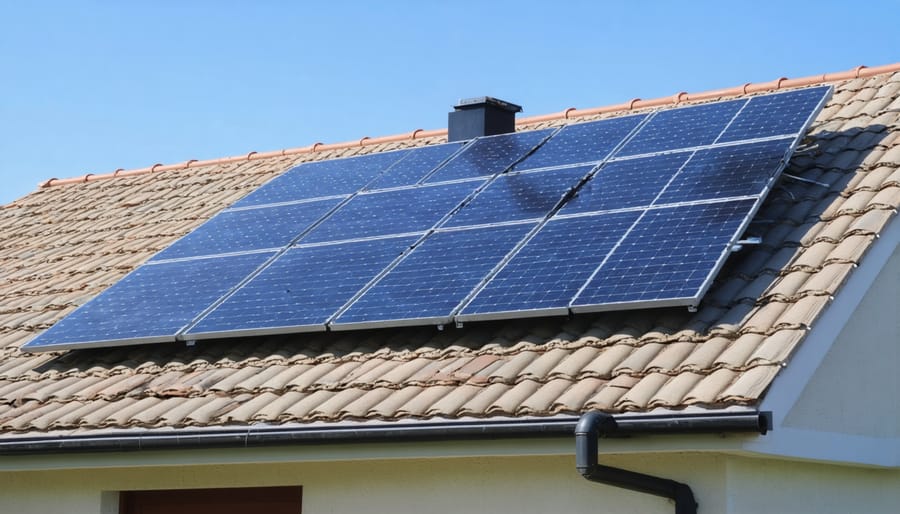
Installation Requirements
Installing a solar-powered water system requires careful consideration of your property’s layout and available space. The most crucial requirement is adequate sun exposure – your installation area needs unobstructed access to sunlight for at least 6-8 hours daily. Like other home solar power systems, the panels should face south in the Northern Hemisphere for optimal performance.
You’ll need sufficient roof or ground space for the solar panels, typically 100-200 square feet depending on your household’s water usage. The installation area must be structurally sound and able to support the system’s weight, including panels, mounting hardware, and water storage tanks.
A level surface near your existing water system is essential for the storage tank placement. This tank should be elevated if possible, allowing gravity to assist water distribution. Most residential systems require a storage capacity of 500-1,000 gallons, so ensure your chosen location can accommodate these dimensions.
The system also needs a dedicated control room or weatherproof cabinet to house the pump controller, batteries, and electrical components. This space should be easily accessible for maintenance but protected from the elements. Additionally, your property should have proper drainage and reinforced plumbing connections to integrate with your existing water infrastructure.
Remember to check local building codes and obtain necessary permits before installation. Most jurisdictions have specific requirements for water system modifications and solar equipment placement.
Maintenance Made Simple
Maintaining your solar-powered water system is surprisingly straightforward and requires minimal effort to keep it running efficiently. Most systems need just a quarterly inspection and annual professional check-up to ensure optimal performance.
Start by regularly cleaning your solar panels – a simple rinse with a garden hose every few months is usually sufficient. During autumn, be sure to remove any fallen leaves or debris that might shade the panels. In winter regions, clear snow accumulation to maintain maximum sun exposure.
Check your pump system’s filters monthly and clean or replace them as needed. This simple task prevents debris buildup and ensures smooth water flow. Monitor your storage tanks for any signs of leaks or damage, particularly after severe weather events.
Your system’s batteries, if present, typically need inspection every six months. Look for signs of corrosion on terminals and ensure proper fluid levels in non-sealed batteries. Most quality batteries last 5-10 years with proper care.
Keep a maintenance log to track inspections and any issues you notice. This record helps identify patterns and predict when components might need replacement. Many modern systems come with monitoring apps that alert you to potential problems before they become serious.
Remember, prevention is better than repair – addressing small issues promptly helps avoid costly repairs and extends your system’s lifespan. Most components are designed to last 20-25 years with proper care.
Solar-powered water systems represent a powerful step toward a more sustainable and cost-effective future for homeowners. As we’ve explored throughout this article, these innovative systems offer multiple benefits, from significant energy savings to increased property value and reduced environmental impact. By harnessing the sun’s endless energy, you can create a reliable water system that works seamlessly with your existing infrastructure while dramatically reducing your carbon footprint and monthly utility bills.
The technology has matured significantly, making these systems more accessible and efficient than ever before. With various options available, from simple solar water heaters to complete pumping systems, there’s a solution to fit every home and budget. The initial investment is offset by substantial long-term savings, government incentives, and increased property value.
Taking action toward installing a solar-powered water system doesn’t have to be overwhelming. Start by assessing your household’s water needs, consulting with qualified installers, and exploring available incentives in your area. Remember that every solar installation contributes to a cleaner environment and a more sustainable future.
As energy costs continue to rise and environmental concerns grow, there’s never been a better time to invest in solar water technology. By making this choice, you’re not just saving money – you’re joining a growing community of homeowners who are leading the way toward a more sustainable future. Take the first step today by requesting a consultation with a local solar installer.







